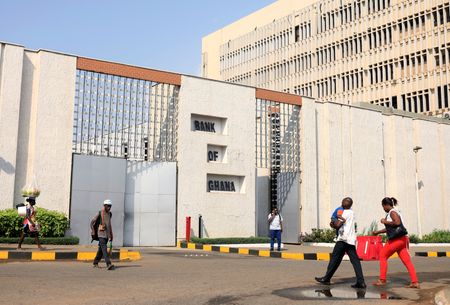By Nicole Jao
NEW YORK (Reuters) – Oil prices edged lower on Tuesday as traders braced for reciprocal tariffs that U.S. President Donald Trump is due to announce on Wednesday, which could intensify a global trade war.
However, Trump’s threats to impose secondary tariffs on Russian oil and to attack Iran fueled supply worries, limiting losses.
Brent futures settled down 28 cents, or 0.37%, at $74.49 a barrel. The session high was above $75 a barrel. U.S. West Texas Intermediate crude futures fell 28 cents, or 0.39%, to $71.20.
On Monday, the contracts settled at five-week highs.
The White House provided no details about the size and scope of tariffs that it confirmed Trump will impose on Wednesday.
“The market is getting a little jittery with less than 24 hours to go,” said Bob Yawger, director of energy futures at Mizuho. “We may lose some Mexican, Venezuela and Canadian supplies, but there is definitely a chance that demand destruction could outpace those barrels,” he added.
A Reuters poll of 49 economists and analysts in March projected that oil prices would remain under pressure this year from U.S. tariffs and economic slowdowns in India and China, while OPEC+ increases supply.
Slower global growth would dent fuel demand, which might offset any reduction in supply due to Trump’s threats.
“While stricter sanctions on Iran, Venezuela and Russia could constrain global supply, the U.S. tariffs are likely to dampen global energy demand and slow economic growth, which in turn will affect oil demand further out on the curve,” SEB analyst Ole Hvalbye said. “As a result, betting on a clear direction for the market has been – and remains – challenging.”
Trump on Sunday said he would impose secondary tariffs of 25% to 50% on Russian oil buyers if Moscow tried to block efforts to end the war in Ukraine.
Tariffs on buyers of oil from Russia, the world’s second largest oil exporter, would disrupt global supply and hurt Moscow’s biggest customers, China and India.
Trump threatened Iran with similar tariffs and also with bombings if Tehran did not reach an agreement with the White House over its nuclear program.
Prices found some support after Russia ordered Kazakhstan’s main oil export terminal to close two of its three moorings amid a standoff between Kazakhstan and OPEC+ – the Organization of the Petroleum Exporting Countries, plus allies led by Russia – over excess production.
Kazakhstan will have to start cutting oil output as a result, two industry sources told Reuters. Another source said repair work at the Caspian Pipeline Consortium terminal will take more than a month.
The market will watch an April 5 OPEC+ ministerial committee meeting to review policy. Sources told Reuters OPEC+ was on track to proceed with a production hike of 135,000 barrels per day in May. OPEC+ had agreed to a similar hike in production for April.
Meanwhile, five analysts surveyed by Reuters estimated on average that U.S. crude inventories fell by about 2.1 million barrels in the week to March 28.
(Additional reporting by Ahmad Ghaddar in London, Jeslyn Lerh in Singapore; Editing by Jan Harvey, David Gregorio and Leslie Adler)











